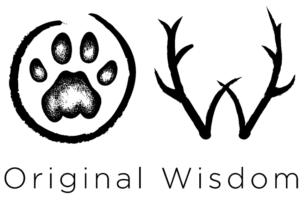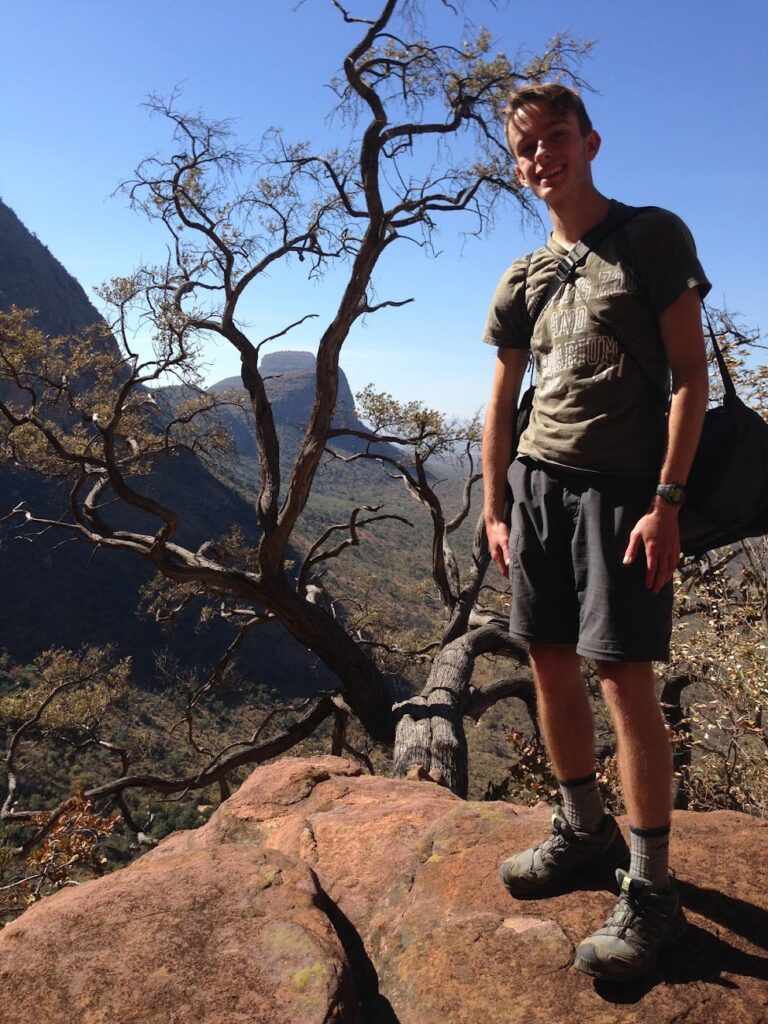Q and A for 14 – 20 April 2020
Answers at a glance: tortoise tracks from South Africa; African lion and spotted hyena tracks from South Africa; dove nest with scats from Chile, South America; grey fox double register and in a straddle trot from Massachusetts, USA; secretarybird track from South Africa; Patriziana brunneus nymphal tubes from South Africa.
Amongst our global efforts to #flattenthecurve, we shared a few tracking photos on our Original Wisdom social media with you, to help pass the time and keep our learning going. Tracking is important, it develops creative and critical thinking skills, and curiosity and empathy, which also help us to better understand our place as caretakers of this beautiful world. We posted a question a day, except for Tuesday because that’s Answer Day!
Wednesday, 22 April 2020
Wednesday’s question comes from the reserve where our Ngala Training Camp venue is in the Greater Kruger area of South Africa.
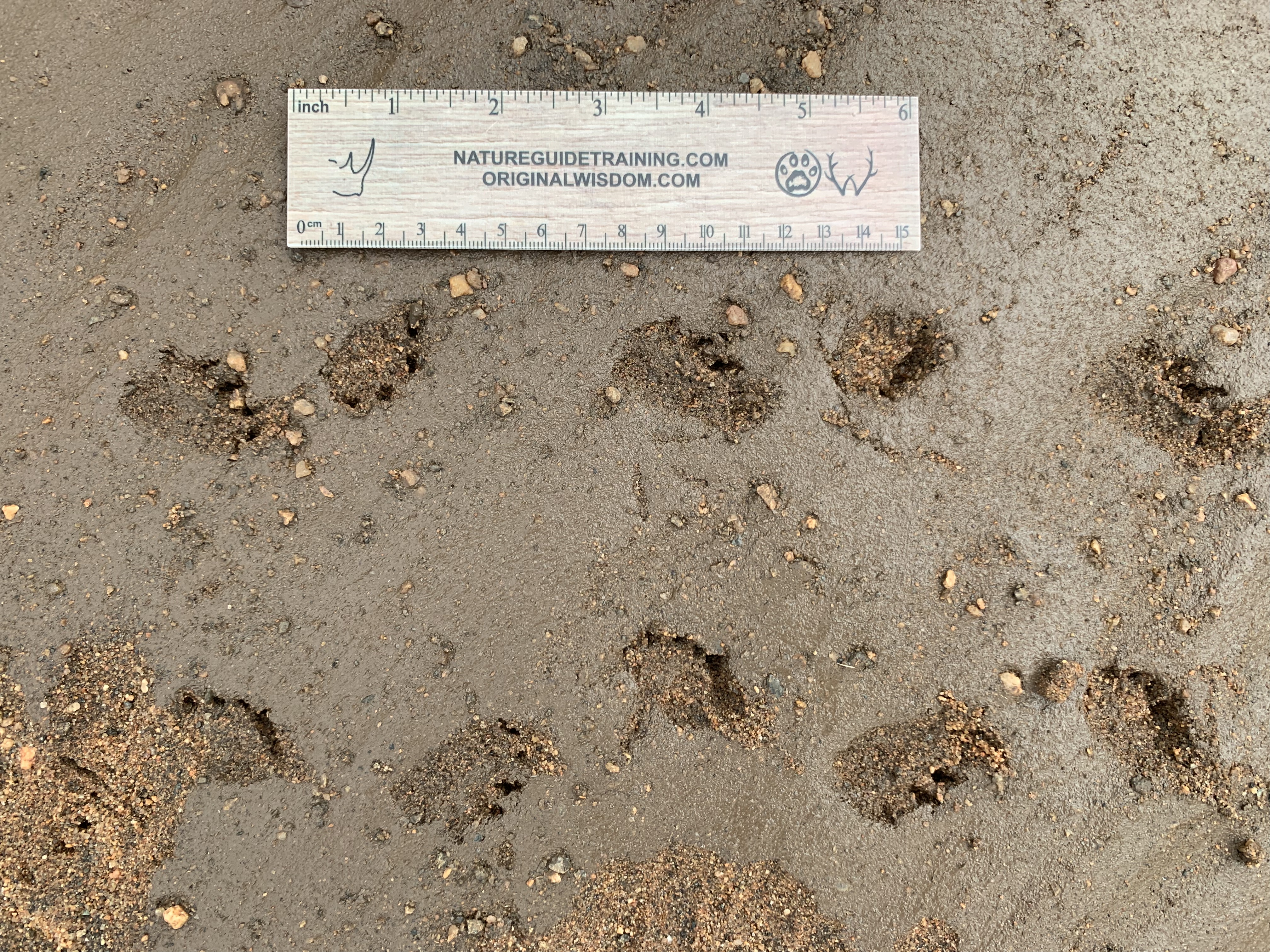
Stuart Wedge (United Kingdom), Chuggy Charles (United Kingdom), and Justene Tedder (Canada) all got this one correct. It’s a tortoise, probably a leopard tortoise. Justene guessed leopard tortoise because, “wide base – love the little nail marks – and leopard tortoise because it is the most common in that area… I usually get a tail drag with the terrapins.” Similarly, Stuart guessed tortoise based in the toe arrangement, where “5 front toes + 5 hind toes” = terrapin vs “5 front toes + 4 hind toes” = tortoise.
We can see in the following drawings from Louis Liebenberg’s A Field Guide to the Animal Tracks of Southern Africa (which can be downloaded for free from the CyberTracker website at http://www.cybertracker.org/tracking/tracking-books) that, theoretically, 5 front toes + 5 hind toes = terrapin vs 5 front toes + 4 hind toes = tortoise.
I question if this is true in all tortoise and terrapin species, though, and would love your input. I often think that the only solid answer we can come to is, “tortoise or terrapin” unless habitat or some other definitive clue gives it away. A good rule-of-thumb, as Justene did, is to guess on the most common species in the region.
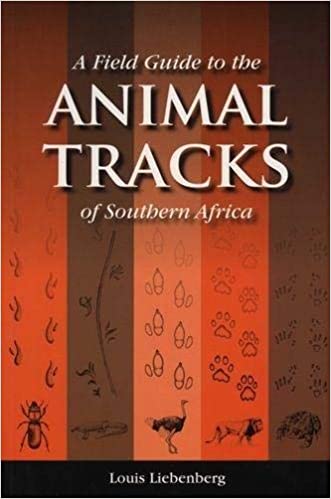
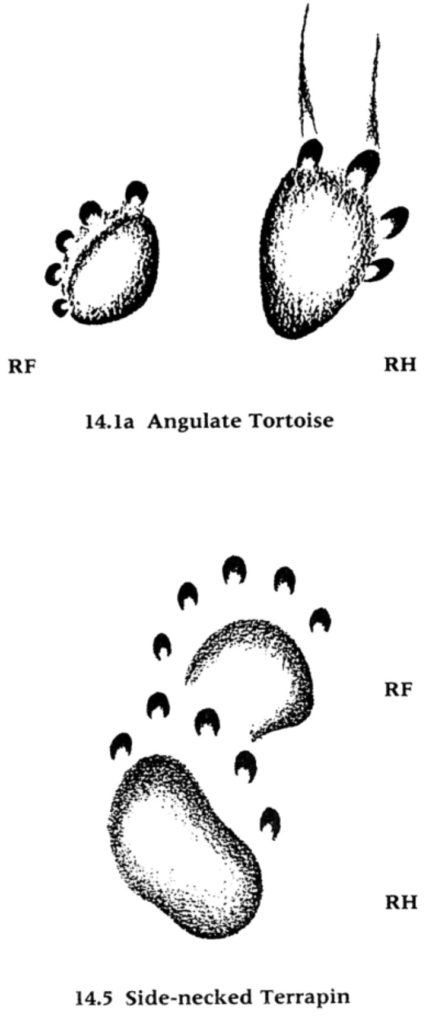
Thursday, 23 April 2020
Thursday’s question comes from the reserve where our Ngala Training Camp venue is in the Greater Kruger area of South Africa. The question is, what two predator species walked by my shadow? Bonus if you can tell us how you would have taken the picture to make it more scientific and easier to answer. (Which wasn’t my intent when I took it, but it is rather “artsy” isn’t it?)
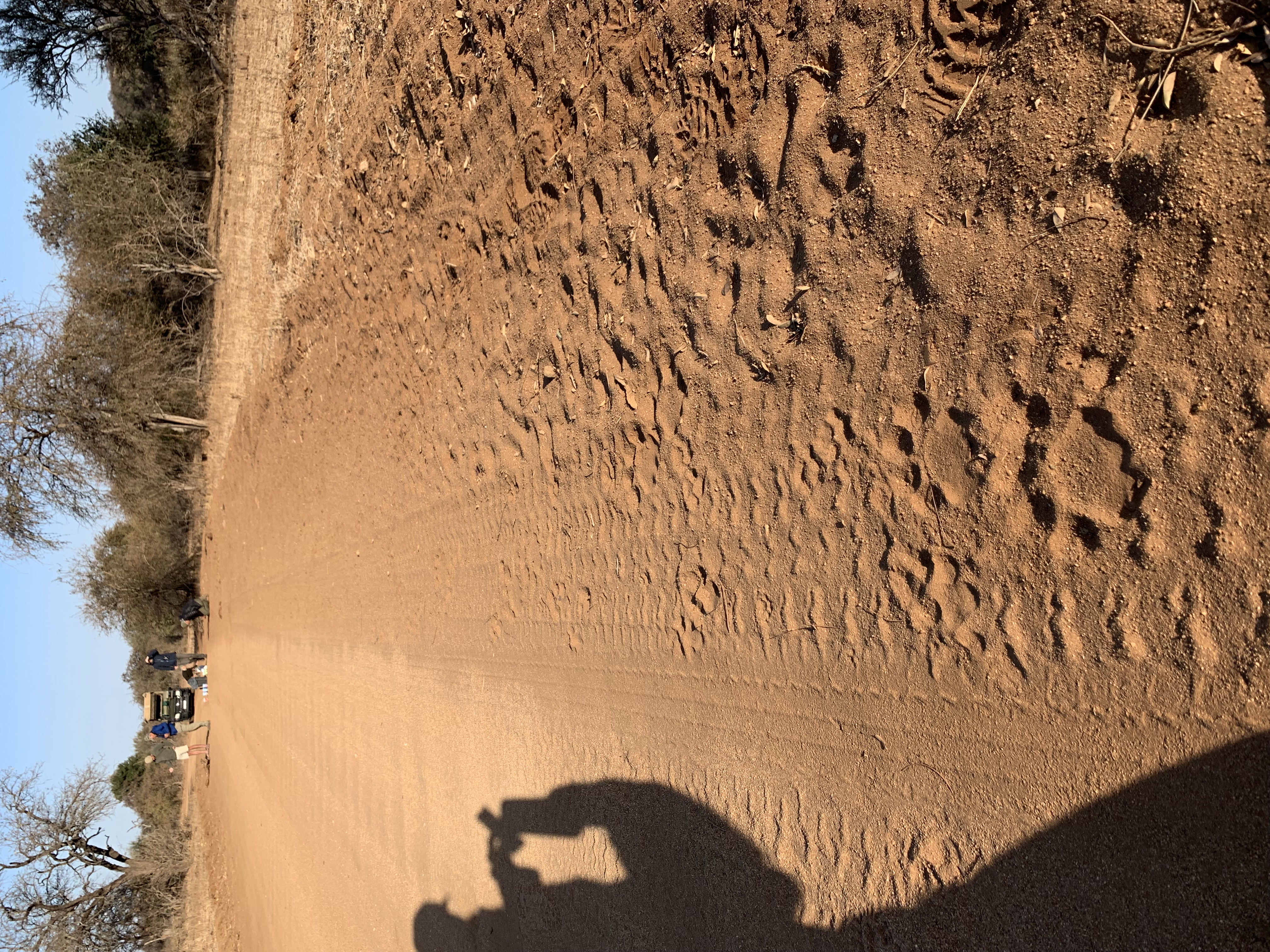
A bunch of people got these ones at least partially correct, including Justene Tedder (Canada), Shane Murdoch (Australia), David Kennedy (USA), and Frikkie Kotze (South Africa).
In this photo, a spotted hyena’s tracks are on the left, moving away from the camera in a classic hyena walk, where the larger front foot on one side of the body pairs with the smaller hind foot of the opposite side of the body in the track pattern. The two asymetrical lobes in the metapodials, and the tightly-fitting, half moon shaped toes are also classic for this species. On the right, a male lion moves in an overstep walk – he has someplace to go and isn’t wasting time. The hind foot oversteps the front foot in the track pattern as he moves along quickly. We see the classic three, equally-sized lobes in the back of the metapodials of a cat, and the small toes relative to the rest of the track.
The other part of the question dealt with how we should attempt to photograph tracks if we are asking for other people to identify the species from photographs, or are trying to teach from the photos. Ideally, you want to take multiple photos, with a ruler in each one. If you don’t have a ruler, use a pen, a coin, your hand, something, to give us a sense of scale, and take some measurements of that object when you get back home and are able to. Take a few close-ups of a few different tracks and pairs of tracks, from directly overhead. This is important because angled photos can distort the size and shape. Then, try to get a photo of all 4 feet (or two in a bipedal animal, etc.), again, from as directly overhead as you can, and with a ruler. This can start to give information about foor placement, and size of the feet relative to each other, etc. Then you want one or two photos looking down the animal’s trial, in the direction it’s going (like the photo above, only with a ruler in it). This will give you information about how the animal was moving, and can be diagnostic with some animals. Finally, take one that includes the tracks in context within the habitat. Habitat can also be a big help, like in trying to guess tortoise or terrapin from Wednesday’s question – if it’s going in and out of the water a lot, then it’s likely to be a terrapin. Whereas if it’s far from water, a terrapin is unlikely. Light and shadow can also be factors in your photography, sometimes one is better than the other for showing details. You can add light with a torch or spotlight in low light conditions, or you can shade a track when the sun is directly overhead – experiment and see what comes out best. We call this set of photos, from close-up to habitat, with scale, a “photo series”.
Friday, 24 April 2020
Friday’s question comes from Torres del Paine National Park in the South American country of Chile. The questions are what kind of a structure is this (who did it and what is it), and what is inside it? The object for scale is a peso coin! (I swear I left a small fortune in the field, by accident, during the two winters that I worked there for my Master’s degree!)
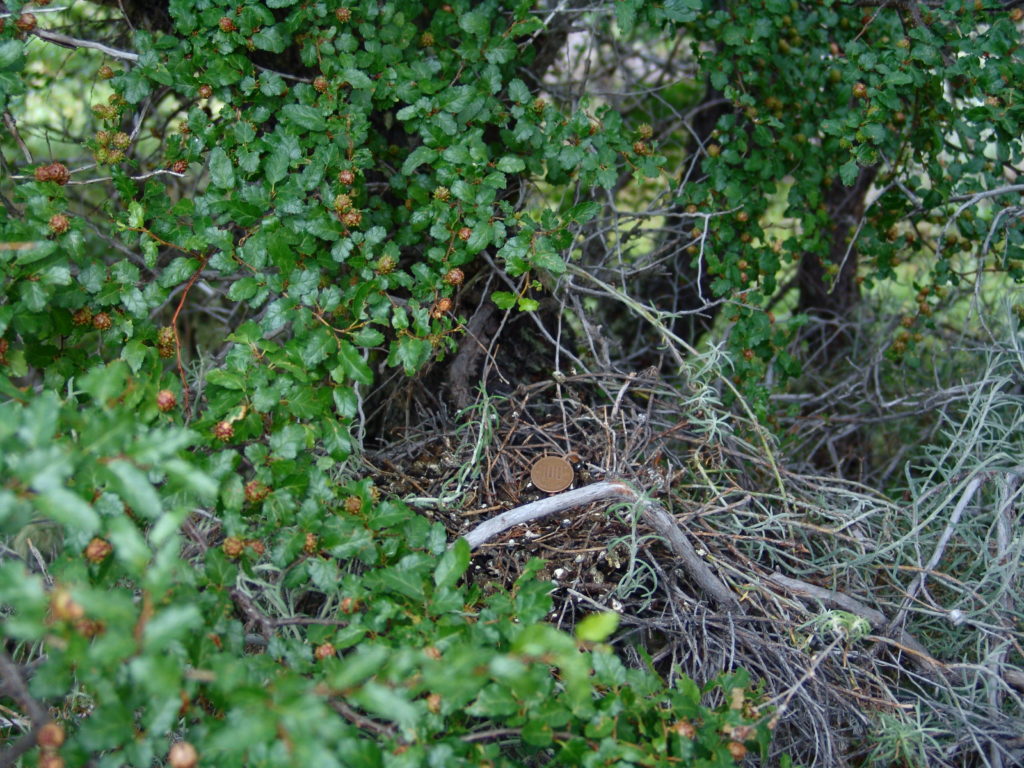
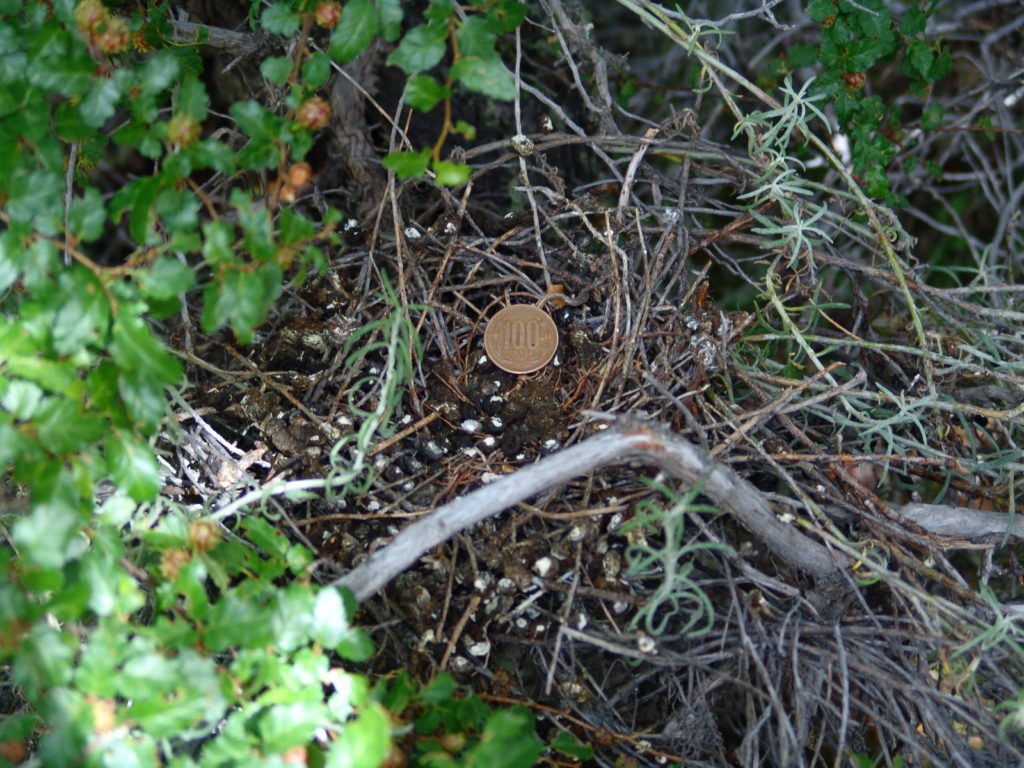
Stuart Wedge (United Kingdom) got that this was a nest, and Sandy Reed (USA), Jim Caretta (USA), and Kim Cabrera (USA) all got to dove (who?) nest and scats (what?), which were the correct answers. The platform of loosely woven sticks that looks like it could fall apart with a slight breeze is classic for doves, and those scats that look like little cinnamon-buns, with glazed icing, are also classic.
Saturday, 25 April 2020
Saturday’s question comes from Plum Island, Massachusetts, in the USA, which is a barrier island off the coast. I’ve provided a close-up of the animal’s track, with a ruler for scale, and a photo of the track pattern that the same animal moved into shortly afterwards. The questions are, what species of animal made the tracks, and what track pattern is it moving in?
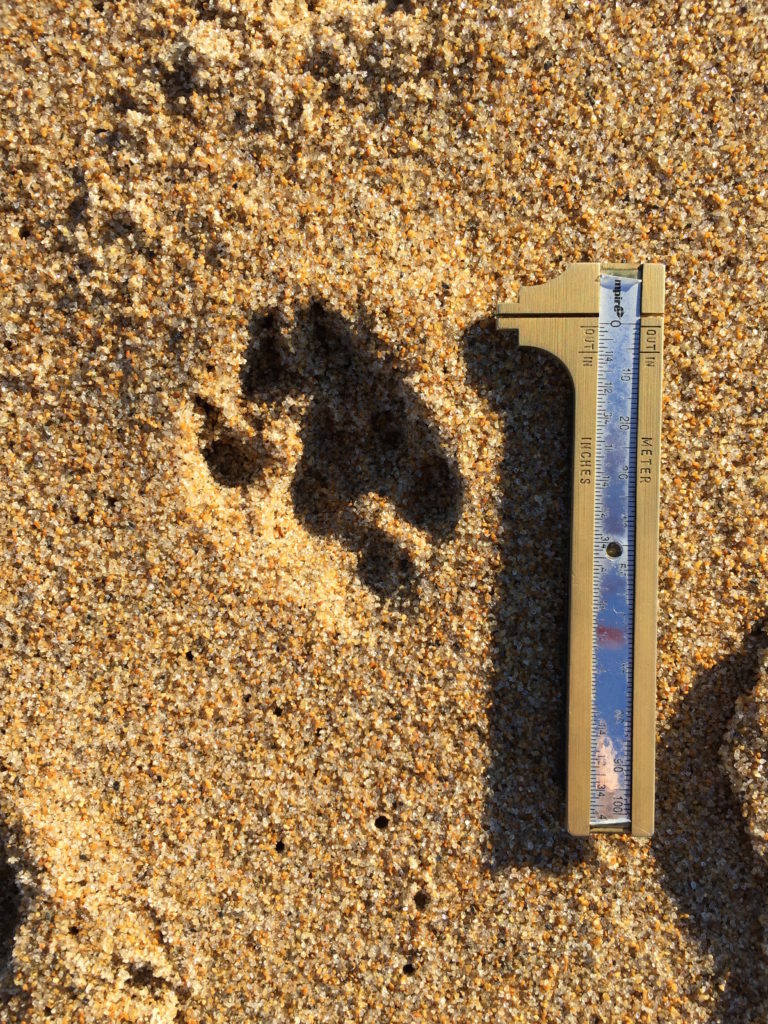
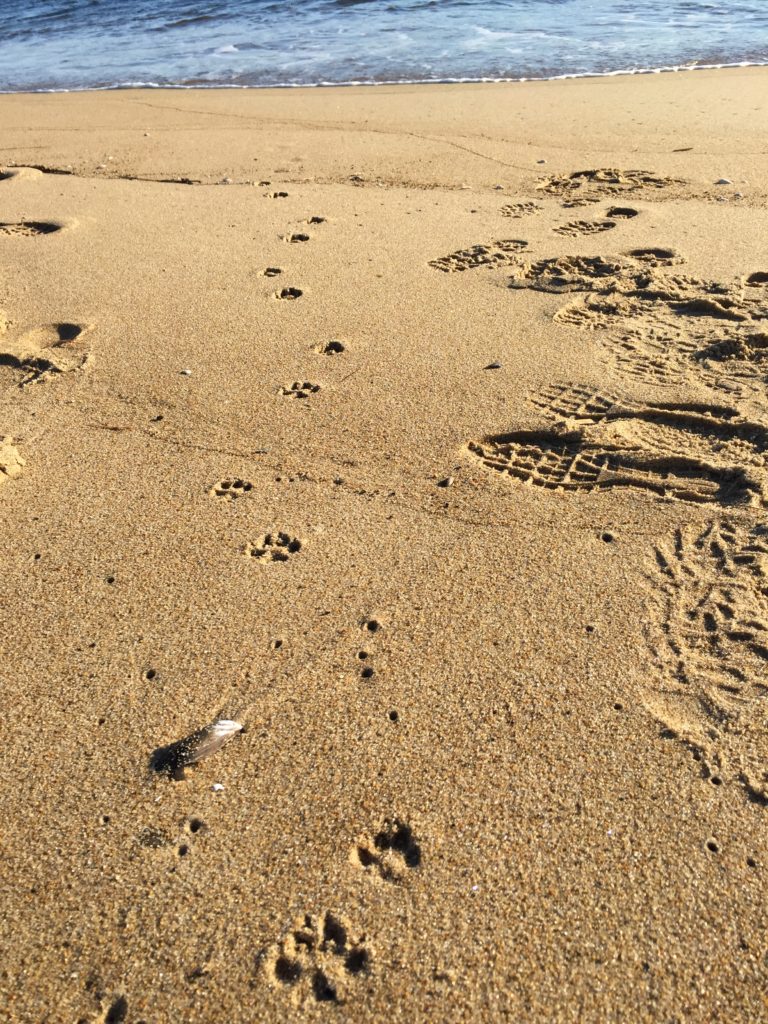
Our three Facebook participants explained this well:
Liz Snair: Fox. Rear pad morphology is a “dot”. Side straddle. Very cool stride. There is no fur showing in the track it could be the only other fox I know of is gray fox.
Kim Cabrera: Gray fox straddle trot. Overlapping tracks with symmetry of the toes, narrower hind track, canine morphology. The gait shows front/hind, space, front/hind, space. The orientation of prints in the gait is a straddle trot, commonly used by gray foxes.
Kirsten Welge: Hm. First impression was coyote. Looking closer at measurements, that’s too small. Canid, leaning wild – tight toes & claws pointing forward, looks like small palm pad imprints shown along the trail where front prints are clear. Clear toe imprints rule out red fox (with their furred feet & obscured toes). I’m measuring the hind print length at 1 3/4″ – way too small for coyote, but at maximum size for gray fox.
Gait is straddle trot, which I’m reading would be a common faster gait for gray fox. Larger front tracks are landing closer to the centerline of the trail, with the smaller hinds landing to the outside of the front prints. So… gray fox, male, straddle trot is my answer.
I couldn’t have said it better, myself.
I also posted the questions to our #trackingisoriginalwisdom Instagram account, and got answers from the following folks: @listeningtoland, @phyredojo, @kirstenwelge
Sunday 26 April 2020
Sunday’s question comes from the Manyeleti region of the Greater Kruger, South Africa. The question is what species made the track?
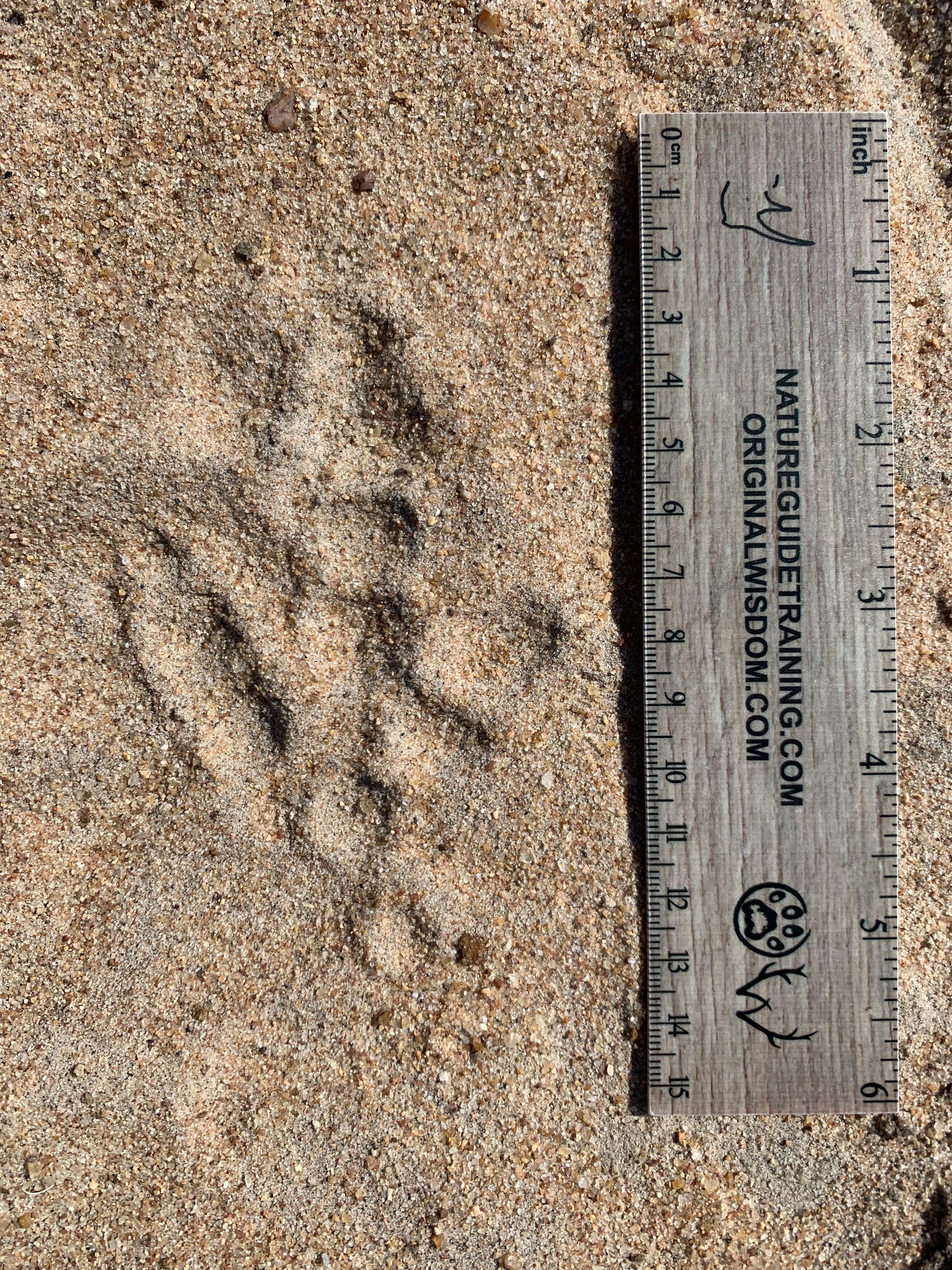
Chuggy Charles (United Kingdom) and Justene Tedder (Canada) nailed this one, but it wasn’t an easy one for some. Justene described it as large with defined ‘lobes on toes’ looks kinda like a bustard but It has the back little toe. It really does look like a bustard or even a vulture track, but it’s not… it’s a secretarybird. Chuggy notices the toe segments (lobes on each toe) 3, 3, & 2, as we can see in the drawing below from Lee Gutteridge’s Birds of Southern Africa and their Tracks and Signs (currently in print, and soon available as an ebook).
Our Instagram participants were: @mannyjb18, @rowan.l.davies, @johnrhyder, @brendanwhite207
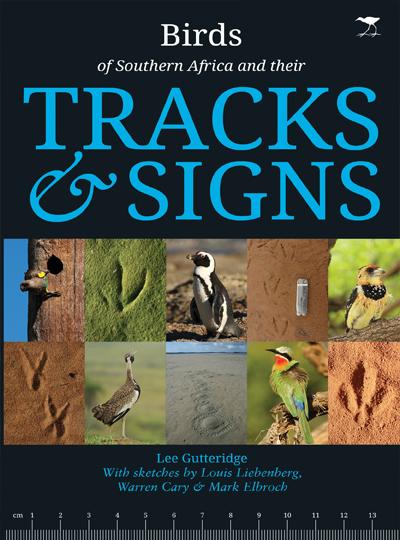
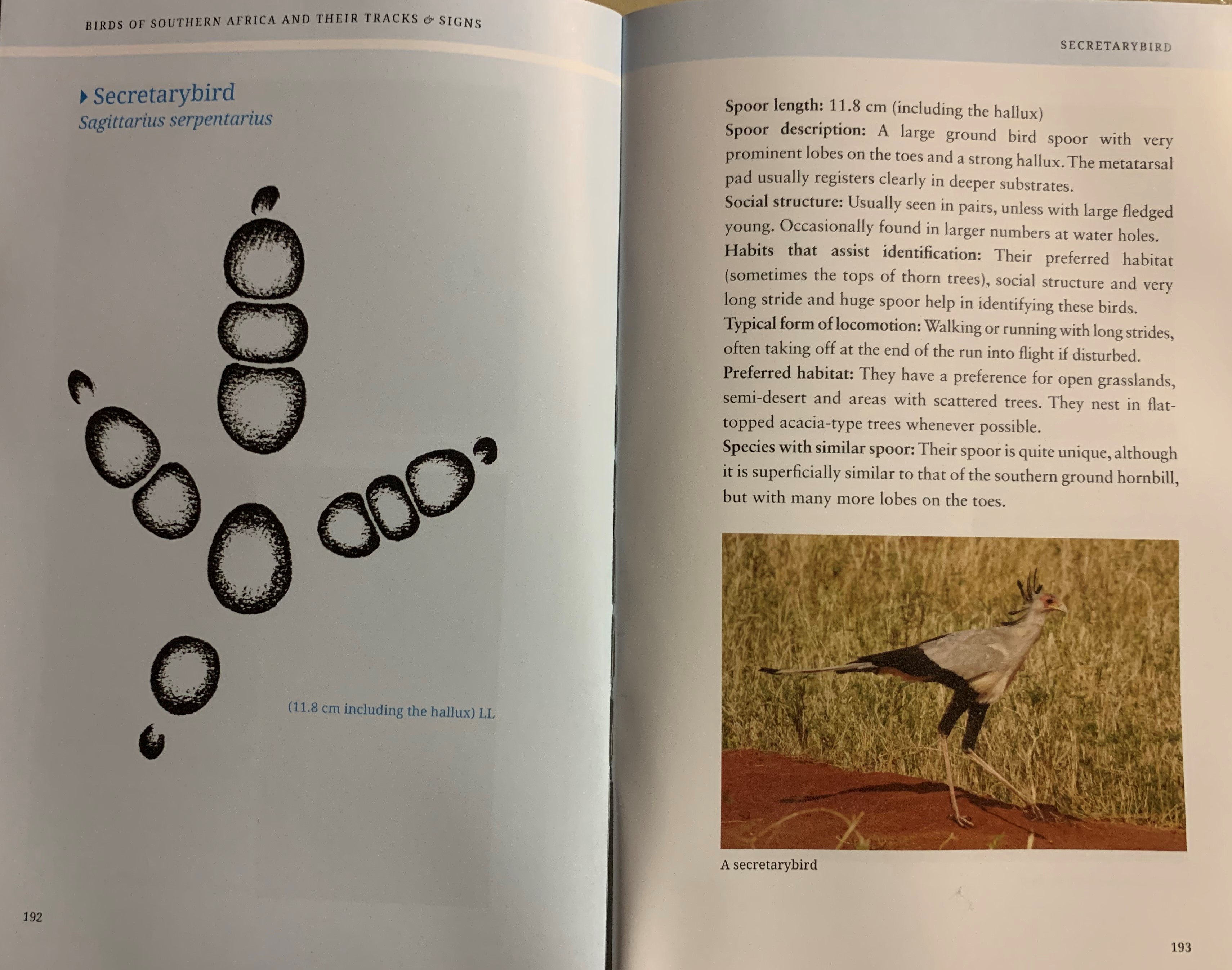
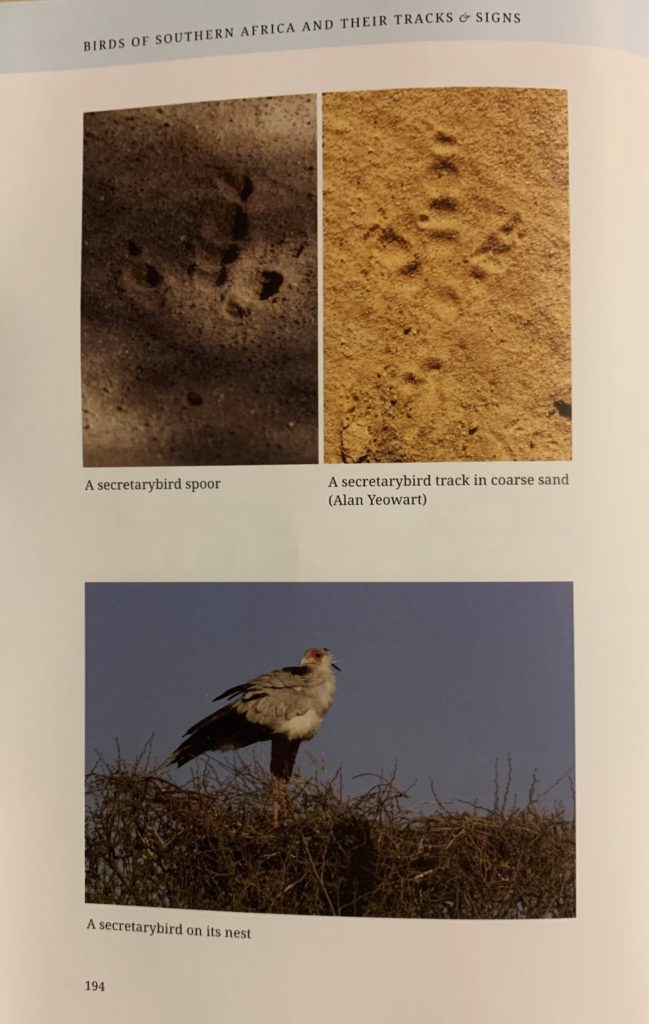
Monday 27 April 2020
Monday’s question comes from our yard (or “garden” as they call it here in South Africa) in Canyon Game Reserve, outlying the Hoedspruit area, but it is widespread in the world. What is it?
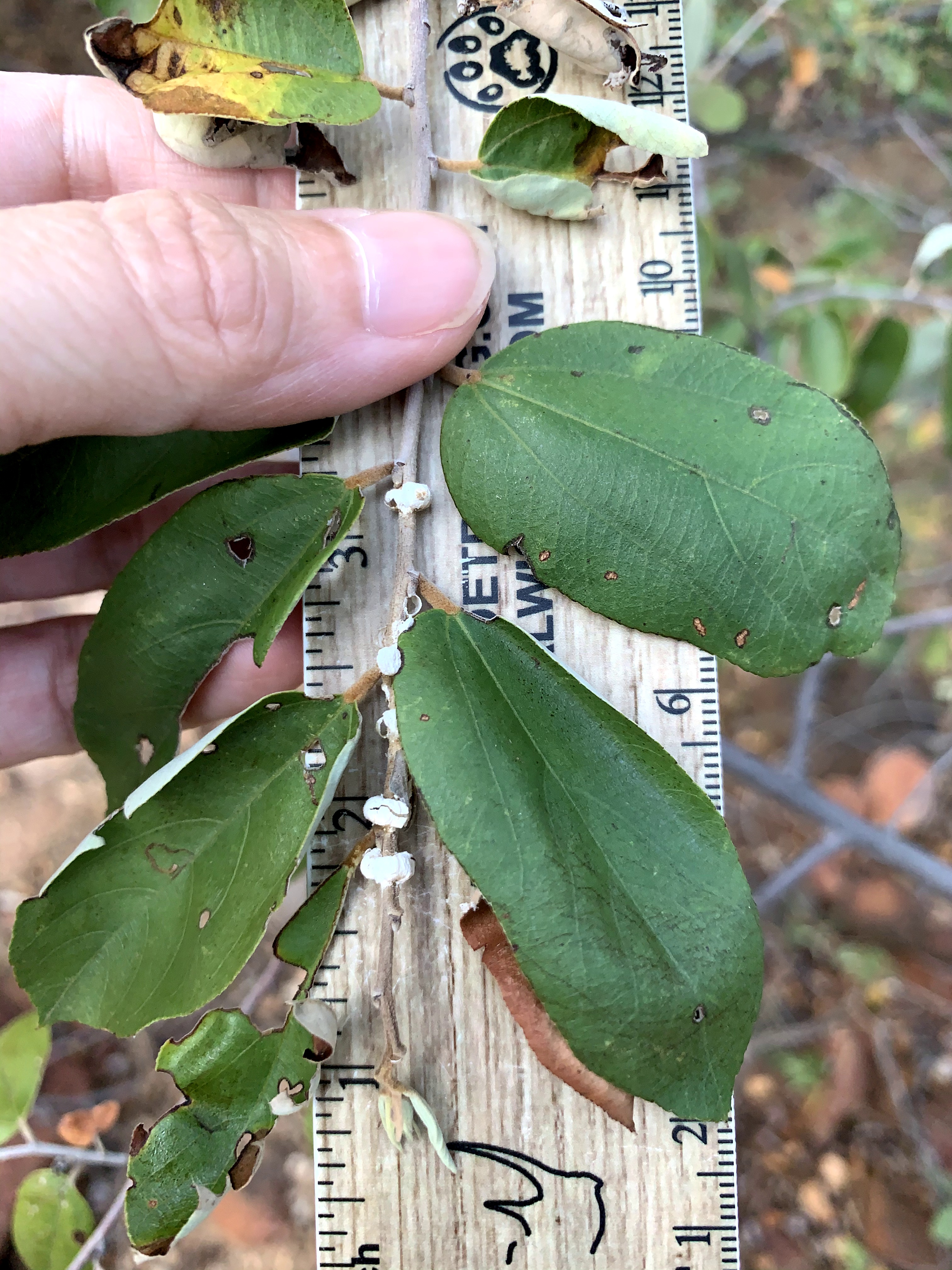
Frikkie Kotze was our only participant willing to answer this one, a tough one, unless you have the book… It looks a lot like Patriziana brunneus. The nymphal tubes of spittlebugs, this time of year they love Grewias. I had to use a reference book, Lee Gutteridge’s Invertebrates of Southern Africa and their Tracks and Signs (available in print and coming soon as an ebook).
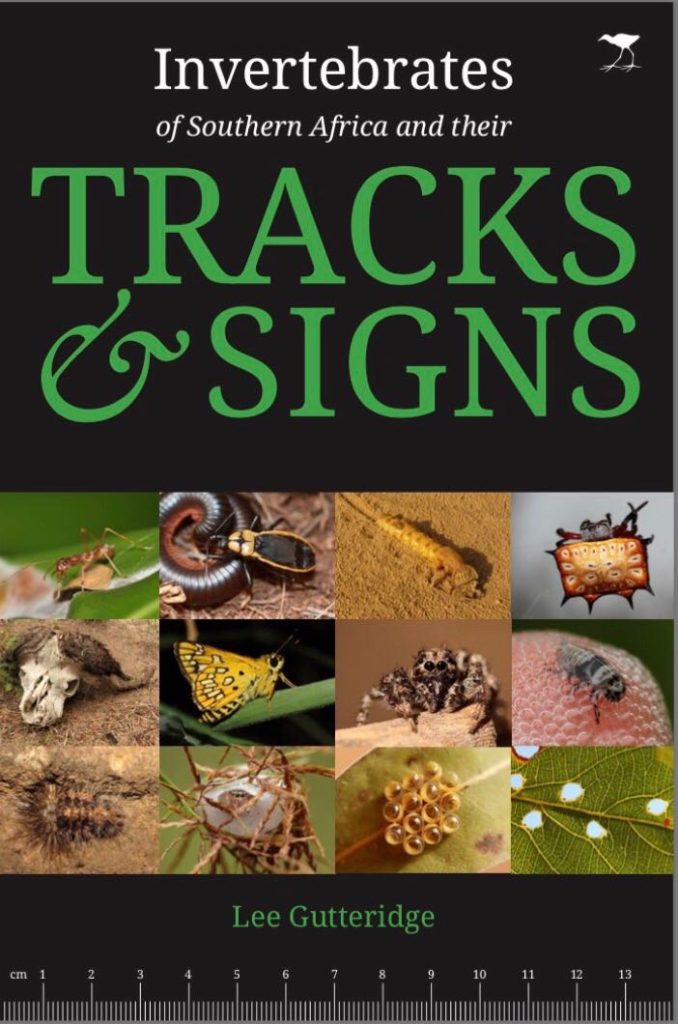
See the following photo of page 328 and 329 for more information on this fascinating species and process:
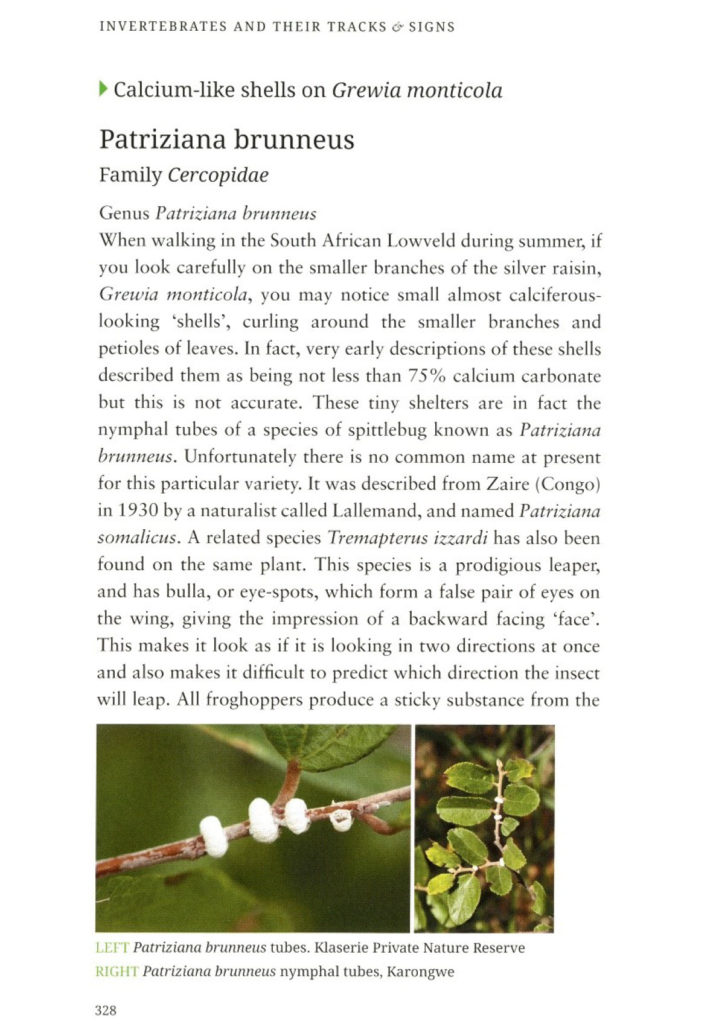
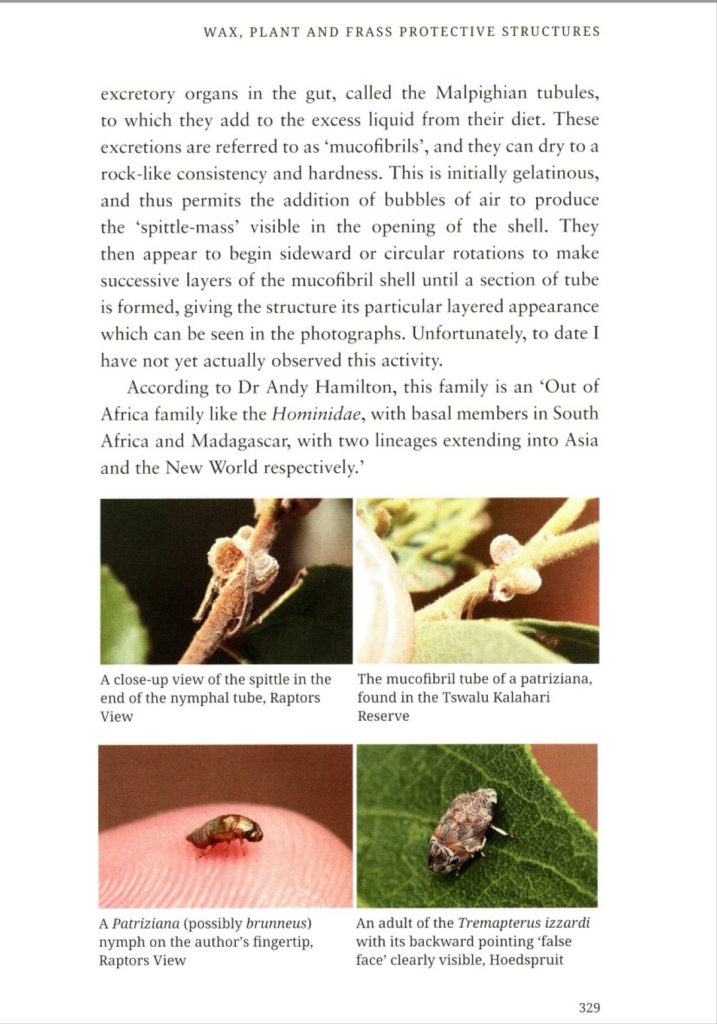
Tuesday 28 April 2020 – Answer Day!
Thanks to everyone who participated. Let’s keep learning together! If you have photos (with an explanation that you’d like to contribute), please contact me at kersey@originalwisdom.com .
#trackingisoriginalwisdom, #natureguidetraining, #cybertracker, #trackercertification, #trackermentoring, #tracksandsigns, #alwaystracking, #ecologicaleducation
Download our recommended reading list for trackers by signing up for this “News for Trackers” newsletter!
Our goal is NOT to be spammy with our newsletter. We’d just like to send occasional updates on upcoming programs and maybe some cool info on wildlife, people, and tracking!
Once the sign-up form has been submitted, you will be re-directed to the download page.
Download our recommended tracking book list (and some other resources). It’s specific to Southern Africa and North America, but, a good tracking book is helpful in any region as a starting point to learn how to look at track morphology and animal behavior.
[contact-form-7 id=”2892″ title=”Subscribe to the newsletter”]
